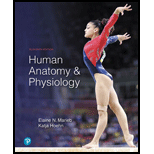
45-Year-Old Female with Motor Nerve Damage
In Chapters 7 and 8, you met Kayla Tanner, who suffered a dislocated right hip in a car accident. Six weeks later, Mrs. Tanner was still unable to walk or run without hip pain, and had weakness in flexion at the knee, excessive foot inversion and plantar flexion, and significant “foot drop” (the inability to dorsiflex the foot).

Electromyography (measurement of muscle electrical activity) and nerve conduction studies (measurement of the speed of nerve impulses) revealed sciatic nerve damage, most likely a result of the nerve being compressed when the hip was dislocated. This large nerve innervates many lower limb muscles. Since her surgery, Mrs. Tanner has been undergoing intense physical therapy and has shown significant improvement.
2. To assess the function and strength of a specific muscle, a physical therapist will often apply resistance (push against the moving limb) to mimic the action of an antagonist muscle. What is an antagonist muscle, and why would the therapist mimic its action?
Want to see the full answer?
Check out a sample textbook solution
Chapter 10 Solutions
Human Anatomy & Physiology (11th Edition)
- Inflamed and swollen tendons caught in the narrow space between the bones within the shoulder joint cause the condition known as ____________________. impingement syndrome intermittent claudicationarrow_forwardA 30-year-old man is stabbed in the arm. There is no evidence of vascular injury, but he cannot flex his three radial digits. He has injured the() A) Flexor pollicis longus and flexor digitus medius tendons B) Radial nerve C) Median nerve D) Thenar and digital nerves at the wrist E) Ulnar nervearrow_forwardProgressive fluctuating muscle weakness, often starting in the favial or eye muscles are signs and sympotoms of which disease? A. Duchenne muscular dystrophy b. Mitochondrial myopathy c. myasthenia gravis d. Fibromyalgia syndromearrow_forward
- an anesthesiologist administered succinylcholine, to provide muscle relaxation to facilitate endotracheal intubation in preparation for surgery' Questions: 1. differentiate the dihydropyridine receptor from ryanodine receptor. 2. discuss the different phase in muscle twitch 3. discuss the sequence of events in a muscle contraction from depolarization of the sarcolemmal 4. How does succinylcholine cause muscle relaxation? how will curare produced the same type of muscle relaxationarrow_forwardGiven the following diseases/conditions, relate them to the events that take place in the neuromuscular junction. Identify the specific cause and the pathologic manifestations of such conditions. Myasthenia gravis Lambert-Eaton Syndrome Neuromyotonia 2. In 3-4 sentences compare and contrast the various types of muscle contraction (See attached picture) and be able to give at least an example for each. What type of contraction causes change in length of muscle fibers? Which type does not result to movement?arrow_forwardPelvic splanchnic neurons function to Choose from the following: (A) increase constriction of the muscles found at the site of the pink/purple dots (B) function to dilate the muscles found at the site of the pink/purple dots (C) function to contract muscles indicated by the black arrows (D) function to dilate muscles indicated by the black arowsarrow_forward
- Motor defects that result from an internal capsular lesion include :-a- Paralysis of all skeletal muscles on the opposite side of the bodyb- Paralysis of all skeletal muscles on the same side of the bodyc- paresis of axial muscles on the same side of the bodyd- paralysis of the distal muscles on the opposite side of the bodyarrow_forwardAny abnormal condition of skeletal muscles is known as _______________________.arrow_forwardParkinson’s disease symptoms include bradykinasia and muscle rigidity Select one: True Falsearrow_forward
- what muscle or muscles may be strained if a patient complains of pain of the following locations: Medial thigh anterior arm posterior neck lateral abdomen posterolateral leg lateral lumbar region of the backarrow_forwarda 20 yrs old man with a neck flexion- extension (whiplash) injury is treated at your outpatient setting two weeks after a motor vehicle accident. what questions would the PT ask concerning his pain? list at least three.arrow_forwardOf the following, which is an attempt to decrease tardive dyskinesia?A. Increased consumption of omega-3 fatty acidsB. Exposure to bright lights in the morningC. Alternating between Thorazine and HaldolD. Use of second-generation antipsychotic drugsarrow_forward
 Human Physiology: From Cells to Systems (MindTap ...BiologyISBN:9781285866932Author:Lauralee SherwoodPublisher:Cengage Learning
Human Physiology: From Cells to Systems (MindTap ...BiologyISBN:9781285866932Author:Lauralee SherwoodPublisher:Cengage Learning Medical Terminology for Health Professions, Spira...Health & NutritionISBN:9781305634350Author:Ann Ehrlich, Carol L. Schroeder, Laura Ehrlich, Katrina A. SchroederPublisher:Cengage Learning
Medical Terminology for Health Professions, Spira...Health & NutritionISBN:9781305634350Author:Ann Ehrlich, Carol L. Schroeder, Laura Ehrlich, Katrina A. SchroederPublisher:Cengage Learning- Essentials of Pharmacology for Health ProfessionsNursingISBN:9781305441620Author:WOODROWPublisher:Cengage





